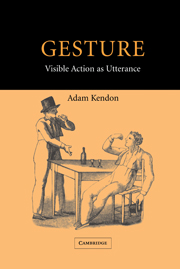Book contents
- Frontmatter
- Contents
- Acknowledgments
- 1 The domain of gesture
- 2 Visible action as gesture
- 3 Western interest in gesture from Classical Antiquity to the eighteenth century
- 4 Four contributions from the nineteenth century: Andrea de Jorio, Edward Tylor, Garrick Mallery and Wilhelm Wundt
- 5 Gesture studies in the twentieth century: recession and return
- 6 Classifying gestures
- 7 Gesture units, gesture phrases and speech
- 8 Deployments of gesture in the utterance
- 9 Gesture and speech in semantic interaction
- 10 Gesture and referential meaning
- 11 On pointing
- 12 Gestures of ‘precision grip’: topic, comment and question markers
- 13 Two gesture families of the open hand
- 14 Gesture without speech: the emergence of kinesic codes
- 15 ‘Gesture’ and ‘sign’ on common ground
- 16 Gesture, culture and the communication economy
- 17 The status of gesture
- Appendix I Transcription conventions
- Appendix II The recordings
- References
- Index
2 - Visible action as gesture
Published online by Cambridge University Press: 05 February 2015
- Frontmatter
- Contents
- Acknowledgments
- 1 The domain of gesture
- 2 Visible action as gesture
- 3 Western interest in gesture from Classical Antiquity to the eighteenth century
- 4 Four contributions from the nineteenth century: Andrea de Jorio, Edward Tylor, Garrick Mallery and Wilhelm Wundt
- 5 Gesture studies in the twentieth century: recession and return
- 6 Classifying gestures
- 7 Gesture units, gesture phrases and speech
- 8 Deployments of gesture in the utterance
- 9 Gesture and speech in semantic interaction
- 10 Gesture and referential meaning
- 11 On pointing
- 12 Gestures of ‘precision grip’: topic, comment and question markers
- 13 Two gesture families of the open hand
- 14 Gesture without speech: the emergence of kinesic codes
- 15 ‘Gesture’ and ‘sign’ on common ground
- 16 Gesture, culture and the communication economy
- 17 The status of gesture
- Appendix I Transcription conventions
- Appendix II The recordings
- References
- Index
Summary
‘Gesture’, we have suggested, is a name for visible action when it is used as an utterance or as a part of an utterance. But what is ‘utterance’, and how are actions in this domain recognized as playing a part in it?
In this book we shall use the term ‘utterance’ to refer to any ensemble of action that counts for others as an attempt by the actor to ‘give’ information of some sort. We draw here upon a formulation of Goffman (1963, pp. 13-14) in which he pointed out that although, whenever people are co present to one another they cannot avoid providing information to one another about their intentions and involvements, about their status as social beings and about their own individual character, and so may be said to ‘give off’ information, people also engage in action that is regarded as explicitly designed for the provision of information and for which they are normally held responsible. Through these kinds of actions, to use Goffman's expression, people are said to ‘give’ information. Here ‘utterance’ will refer to any action or complex of actions that is treated by the participants within the interactional occasion, whatever this might be, as ‘giving information’ in this sense. That is, an ‘utterance’ is any unit of activity that is treated by those co-present as a communicative ‘move’, ‘turn’ or ‘contribution’.
- Type
- Chapter
- Information
- GestureVisible Action as Utterance, pp. 7 - 16Publisher: Cambridge University PressPrint publication year: 2004
- 2
- Cited by

